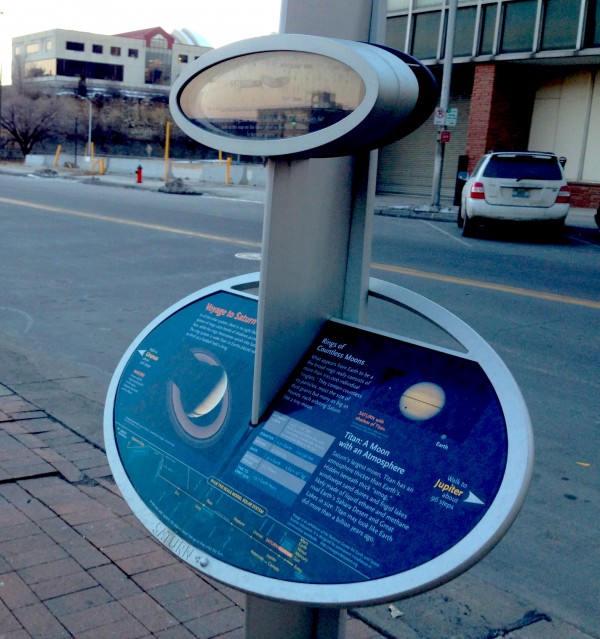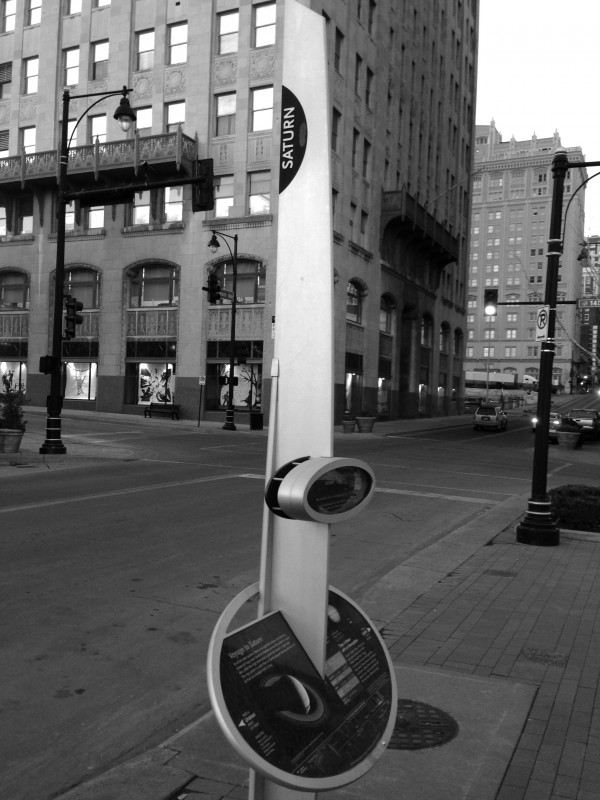From Frontier Town to the Final Frontier
Permanent one-mile outdoor installation, solar system tour, 13th & Baltimore, outer space education
Kansas City may not be the first place that comes to mind when Americans think of space exploration. Fixed neatly in the middle of the country, far from the launch pads of Cape Canaveral or Houston’s Mission Control, the curious cosmophiles of Kansas City may feel limited in their options to learn more about the universe. This is exactly what the Ewing Marion Kauffman Foundation set out to change with their Voyage: A Journey through the Solar System exhibition.
Installed downtown in 2008, the permanent installation runs a mile through the city and offers a model of our solar system—at a scale easily seen by the naked eye. Voyage is inspired by a model on the National Mall, and replicates its scale—one ten-billionth the size of the solar system—to offer pedestrians downtown a chance to explore space from the sidewalks.
Voyage takes off at 13th Street and Baltimore, where the first of a series of steel towers is topped with a copper model of the sun. As viewers walk south down Baltimore, they can stop at each tower and see representations of planets, their moons, and even asteroid belts.
It’s remarkably different scenery than what passersby could once find on that corner in the 1920s. As the Jazz Era raged throughout downtown Kansas City, the only education likely to be found on the corners of 13th Street were bedroom lessons from the ladies. Something of a Red Light district in its heyday, the area provided shop windows displaying barely-clothed women and housed nearby gentlemen’s clubs such as the Chesterfield Club, which offered scantily-clad cocktail waitresses.
Kansas City had been a model frontier town throughout the 19th century, with its fair share of gamblers, drinkers, and outlaws. It’s no surprise that as the lawless fun rolled on into the 1920s, Kansas City upheld its reputation as a city of scintillating sin. Hard-nosed progressives and Prohibition teetotalers of the era with an interest in cleaning up the downtown quarter would surely rejoice at the appearance of an educational tool running down Baltimore Avenue.
Indeed, the Voyage exhibit is a popular stop for starry-eyed school children, though its educational interest is certainly not age specific. Project visionary Jeff Goldstein, the director of the National Center for Earth and Space Science Education in Maryland, is responsible for a number of national initiatives that seek to better educate students, families, and communities about space exploration. He led the group that created the first Voyage on the nation’s capital, with a proportionally giant vision of what the exhibit could provide: the experience of walking through space.
Visitors to Voyage in Kansas City are treated to an experience on the same scale as the original in D.C.—unique from two other replicas in Texas. By the time an earthbound cosmonaut has walked the full mile to the final tower—a model of Pluto in front of Union Station—they have had the opportunity to stroll with space with a heightened understanding they wouldn’t get from a telescope.












